
 |
|||||
|
|
|||||
|
|
|
|||||
|
|
|
|
|
|||
|
|
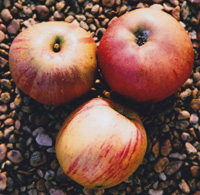 |
WINDMILL WONDER Colin Dancer owns Windmill Farm at Quainton, Buckinghamshire, as have his ancestors, and like most ancient farms it comes with an orchard of old trees. It also comes with a magnificent, still working, windmill. Against the orchard is a very sunken green lane, eroded by the toil of endless carts that have brought grain and carried flour away, in ages past. There are three, possibly four, apple trees there that have unmatched DNA and this one has been named by Mr Dancer. A medium to large dual purpose apple. When ripe in October it is pale yellow with finely pencilled red stripes. The flesh is quite fine but it is crisp enough and juicy, though not very juicy. The flesh is sweet, the flavour rich and the acidity low. A good eating apple but even better when cooked. It cooks very quickly and keeps its shape well. It has now developed an even richer flavour, is still very sweet and now fruity. It does not give up much juice and will make a very tasty tart. Pollination Group5 |
||
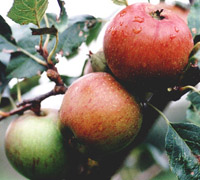 |
WINSTON Raised in 1920 by William Pope of Welford Park, Berkshire, named Winter King in 1935 and then renamed Winston in 1944, after Winston Churchill. (Taylor says it was raised by Messrs Pope, of Wokenham, and renamed Winston in 1945). It was a cross between Cox’s Orange Pippin and Worcester Pearmain. A medium sized fruit, conical and boldly streaked with red, over green. Flesh is crisp, pale and sweet with the flavour of a Cox. Ripe in late October, it will store until March. Pollination Group 5 |
|||
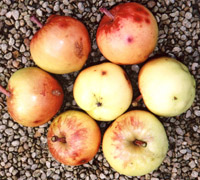 |
WINTER
BANANA An American apple which originated in 1876 on a farm at
Cass County in Indiana, owned by David Flory. It was exhibited in London
and became a very popular import by the 1900's. By the 1920's it was growing
in Britain. A bright yellow, dessert apple with red flushes and russet
streaks. The flesh is juicy, melting and very aromatic, with a distinct
banana flavour. It is still grown commercially in Europe for juice pressing.
Pollination Group 4 |
|||
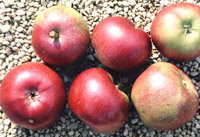 |
WINTER
COLMAN Probably a Norfolk apple and also called Winter Coleman,
Norfolk Coleman, Norfolk Storing and Black Jack. The earliest reference
is in Forsyth (1810). It has been confused with Norfolk Beefing and the
accession in the National Fruit Trials turned out to be Norfolk Beefing,
so the last time Winter Colman was known to be in Britain was 1885, when
included in the Herefordshire Pomona. It was a well regarded large apple
of freckled pale yellow on the shady side and bright mahogany red on the
sunny side. The flesh is firm, sweet and juicy, but not the best for dessert.
Hogg called it a first rate culinary apple, in use from November to March.
We find it keeps its shape when cooked and becomes richer than uncooked.
Though there might be surviving trees in Britain, no named example had
been found and it is absent from European collections. It was discovered
by us in the Grove Research Station in Tasmania, and new trees were grafted
in 2005. Having compared the fruit to Norfolk Coleman, they do appear
to be different, though similarly coloured and the same shape. Winter
Colman lasts longer over the winter. Pollination Group 4 |
|||
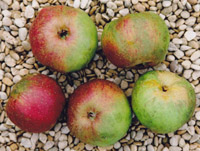 |
WINTER
GREENING An old and valuable apple, assumed of Oxfordshire origin,
but once widely grown. History has wrongly concluded that Winter Greening
and French Crab were the same. The first reference we have found to Winter
Greening, was by Abercrombie in 1779, who described it as ‘A very
large green apple. No references to French Crab predate that, and it seems
that Forsyth (1810) was the first author to note French Crab. It was believed
that French Crab was imported to Britain in the 1790s, or perhaps a little
earlier. The confusion seems to have arisen with Scott (1872) and was
carried forward by Hogg (1884). It is one of many examples where confusion
between varieties leads to their being merged and a synonym being created.
In this case Scott gave Winter Greening as a synonym of French Crab, but
this did not mean that Winter Greening did not exist as a separate apple.
Hogg assumed they were the same, in error. Later writers tried to make
the facts fit the naming and the National Apple Register of 1971 took
both together and merged all of their synonyms. Winter Greening seemed
not to exist. Yet we have two very different apples, one named French
Crab and the other named Winter Greening. In the first London Horticultural
Society catalogue of 1826 French Crab and Winter Greening were included
separately. The same applied to their 1842 catalogue. Yet Taylor in 1946,
referring directly to both catalogues wrongly says that Winter Greening
was included as French Crab. He, however, lists both with different descriptions,
albeit with a lack of confidence. In the catalogue of the Apple and Pear
Conference of 1934, both were exhibited and kept separate in the catalogue.
They had French Crab, with a synonym of Winter Greening, and also Winter
Greening, with a synonym of John Apple. The true John Apple was known
to Shakespeare and is now ‘missing’. Winter Greening at The
Apple and Pear Conference was exhibited from both Staffordshire and, interestingly,
Oxford – where ours came from. Lindley in the 1830s, wrote of French
Crab under the name Easter Pippin, but did not make it synonymous with
Winter Greening. Somewhere between Lindley and Scott (1872) they became
confused, later they were merged to become the same. The full evidence
requires that they be separated again. It may be that Winter Greening
and the historic John Apple are the same. It may also be that Winter Greening
and Somerset Stone Pippin are the same. Scott’s good description
of the latter is in full accord with our Winter Greening and Somerset
Stone Pippin is a known synonym of Winter Greening. The apple we now have
as Winter Greening was introduced to us by the late Joy Midwinter of Witney.
Her grandfather planted an orchard at Wolvercote Church, near Oxford,
in 1911 and, while living there from 1937, she remembers her father calling
one of the varieties ‘Winter Greening’. Two old trees of it
still bear well. It is a superb culinary apple, as well as a delicious
eater when fully ripe. It is quite a dense apple – crisp, very juicy
and with sweet, fragrant flesh. It is ripe in October and will keep well
into the Spring. At the end of the year it is still a good crisp dessert
apple with full flavour. When cooked it softens quickly, but keeps its
shape. The flavour is excellent, without the need for sugar. A medium
to large, conical to oblong apple with skin of pea green, becoming golden,
streaked with deep red. The body and eye cavity are ribbed. A very attractive
and useful apple. Trees have an ornamental arching habit. Pollination
Group 4 |
|||
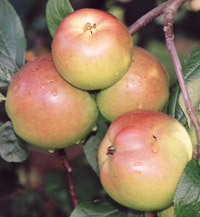 |
WINTER
MAJETIN Known before 1810 when it was listed by Forsyth, but
probably existing in the first half of the 18th century. Lindley promoted
it for disease resistance and introduced it to the London Horticultural
Society collection before 1826. Lindley considered it a Norfolk apple.
He remarked upon an old tree growing in a garden in Norwich, in the 1820s.
A medium to large sized culinary apple, with five crowns at the eye, like
London Pippin, according to Hogg, but where the green skin does not change
to yellow. Bunyard disagrees and says it does turn yellow. We agree with
Bunyard. The skin takes on a brownish red flush in the sun. The flesh
is green-white, crisp, tart, and with a pleasant flavour. Late season,
storing to May. It is a freely cropping variety which is said to need
thinning to avoid small fruits. It has a reputation for resisting Mealy
Bug and Woolly Aphid (also called American Blight). Bunyard said it was
used as a rootstock in Australia for this reason. It cooks to a tasty
purée and has reputedly been used for cider as well as being an
acceptably sharp dessert apple. Pollination Group 6 |
|||
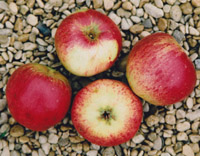 |
WINTER
PEARMAIN The Winter Pearmain is one of the oldest English apples,
mentioned and described by Gerard in 1597. It was also called the Old
English Pearmain, though the currently known Winter Pearmain is different
to Old Pearmain. It was confused with the Winter Queening, and sold under
that name in the 19th century, and there is still some confusion. We cannot
be sure that the tree still in existence is the original Winter Pearmain,
but it has a very close resemblance according to the historical description.
The medium sized apple is ribbed, flattish and green, with pronounced
scarlet flushing. Apples will keep over a long period and are best used
after storage for a while. It is useful for cooking, dessert and cider
making. It must be left to ripen fully in November, when it is a good
eating apple. T*. Pollination Group 2 |
|||
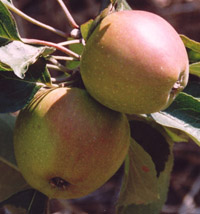 |
WINTER
QUEENING This apple is possibly pre-Tudor. In 2004 we discovered
it, named as Winter Queening, in the collection at the Grove Research
Station, Tasmania. The first trees were grafted in 2005. RHS Wisley also
have an apple of this name in their collection, and theirs appears to
match the historic description as well. They appear to be the same. The
medium sized apples are slightly longer than wide, conical and red striped
over yellow. A late apple that will keep over the winter and which was
historically used for dessert, cooking and cider. Flesh firm rather than
crisp and juicy, but full of flavour. Pollination Group 3 |
|||
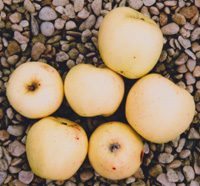 |
WINTER
WEASEL The Polecat Public House, at Prestwood, Buckinghamshire,
contained several old and interesting apples in its extensive orchard
garden, and we took scions of all, with the permission of the former owner,
John Gamble, in 2005. Unfortunately the new owners have removed most of
the trees to enlarge the car park.The fruits bore all the hallmarks of
varieties planted to provide both food and cider for the old Inn’s
guests. The trees were at least a century old and many very old. We have
named them after the Mustelid family of creatures. Winter Weasel is a
pale skinned cider apple, sweet and tannic and ripe in October, though
lasting to the year end and staying juicy but losing flavour. Small green
apples of variable shape, becoming yellow, with matt skin and with dryish
flesh, tannic, low acidity and mild sugar. Pollination Group 4 |
|||
|
||||